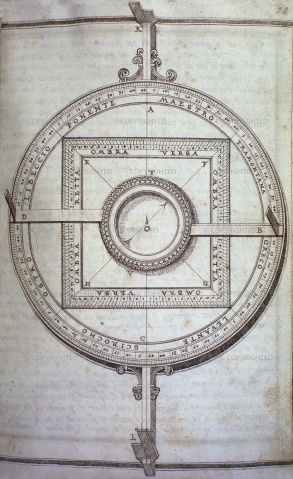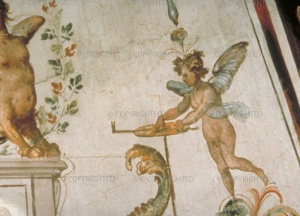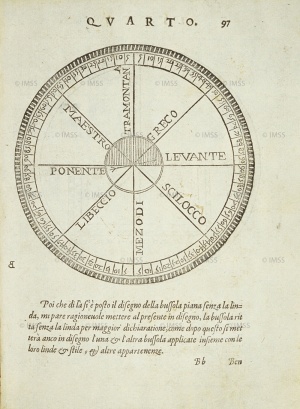Surveying Compass
From Inventions
| (4 intermediate revisions not shown) | |||
| Line 1: | Line 1: | ||
{{Template invention | {{Template invention | ||
| - | |nome= | + | |nome= |
| + | Name currently used to distinguish the instrument used for surveying from the instrument of orientation also called [[compass]]. | ||
| - | |descrizione= | + | |descrizione= |
| + | Goniometric circle similar to the [[horizon]] of Leon Battista Alberti but equipped with diopter and magnetic needle. The circumference is divided into 8 sectors designating the directions of the winds (Tramontana, Greco, Levante, Scirocco, Ostro, Libeccio, Ponente, Maestro), and each part is divided generally into 45°, for a total of 360°. In Raphael’s famous letter to Pope Leo X (c.1515), containing a first description of this instrument, the suggested division is 4 degrees for each wind, for a total of 32 degrees. The position angle of a place is read in relation to the direction of the wind blowing from the sector of the circumference carrying the diopter. The instrument is named for the [[compass]] usually found at the centre of the graduated disc. | ||
|inventore= | |inventore= | ||
| Line 12: | Line 14: | ||
|riferimentibibliografici= | |riferimentibibliografici= | ||
| - | |||
| - | |||
Bartoli, Cosimo. ''Del modo di misurare le distantie, le superficie, i corpi, le piante, le provincie, le prospettive, & tutte le altre cose terrene, che possono occorrere a gli huomini...'', Venezia, Francesco Franceschi, 1564.<br /> | Bartoli, Cosimo. ''Del modo di misurare le distantie, le superficie, i corpi, le piante, le provincie, le prospettive, & tutte le altre cose terrene, che possono occorrere a gli huomini...'', Venezia, Francesco Franceschi, 1564.<br /> | ||
| + | |||
| + | Sanzio, Raffaello. ''Memoria a Leone X'', in Raffaello Sanzio, ''Tutti gli scritti'', a cura di Ettore Camesasca, Milano, Rizzoli, 1956, pp. 51-64.<br /> | ||
|strumentiesistenti= | |strumentiesistenti= | ||
| - | [http:// | + | - Museo Galileo, Institute and Museum of the History of Science, Florence <br> |
| - | [http:// | + | [http://catalogue.museogalileo.it/object/Theodolite_n01.html Florence, Museo Galileo. Institute and Museum of the History of Science, inv. 154.]<br /> |
| - | [http:// | + | [http://catalogue.museogalileo.it/object/SurveyingCompass_n01.html Florence, Museo Galileo. Institute and Museum of the History of Science, inv. 1279.]<br /> |
| - | [http:// | + | [http://catalogue.museogalileo.it/object/SurveyingCompass_n02.html Florence, Museo Galileo. Institute and Museum of the History of Science, inv. 144.]<br /> |
| - | [http:// | + | [http://catalogue.museogalileo.it/object/SurveyingCompass_n03.html Florence, Museo Galileo. Institute and Museum of the History of Science, inv. 3371.]<br /> |
| + | [http://catalogue.museogalileo.it/object/SurveyingCompass_n08.html Florence, Museo Galileo. Institute and Museum of the History of Science, inv. 2506.]<br /> | ||
| + | |||
| + | |||
| + | - The Science Museum, London<br> | ||
| + | [http://www.ingenious.org.uk/site.asp?s=S2&DCID=1979-256# The Science museum, inv. 1979-256]<br> | ||
| + | |||
| + | |||
| + | - Museum of the History of Science, Oxford <br> | ||
| + | [http://emu.mhs.ox.ac.uk/Display.php?irn=9282&QueryPage=%2FAdvQuery.php Museum of the History of Science, Oxford, inv. 86999]<br> | ||
| + | |||
| + | |||
|link= | |link= | ||
| + | http://www.isissbuonarroti.it/museo/19.htm (Italian)<br> | ||
| + | http://www.itgalucca.it/aggiornabili/documentazione/Nottolini/museo/schedf5.htm (Italian)<br> | ||
| + | http://americanhistory.si.edu/collections/surveying/type.cfm?typeid=1 (English) | ||
| + | |||
| + | |||
| + | |||
|immagini= <gallery widths=300 heights=480 perrow=3> | |immagini= <gallery widths=300 heights=480 perrow=3> | ||
| Line 31: | Line 50: | ||
Image: 5247_1652_1553-024.jpg|Antonio Santucci, ''Trattato di diuersi istrumenti matematici che si conseruano al presente nella Guardaroba del Gran Duca di Toschana presi in disegno in questo libbro, con le loro operazioni come in misurare le lunghezze, largezze, altezze ouero profondita, così delle cose terrene come celesti, similmente in leuar le piante delle prouincie o di qual si voglia cosa con ogni particolarità che giustamente stien ne luoghi loro'', ms., 1593, Firenze, Biblioteca Marucelliana, Ms. C 82, c. 32a | Image: 5247_1652_1553-024.jpg|Antonio Santucci, ''Trattato di diuersi istrumenti matematici che si conseruano al presente nella Guardaroba del Gran Duca di Toschana presi in disegno in questo libbro, con le loro operazioni come in misurare le lunghezze, largezze, altezze ouero profondita, così delle cose terrene come celesti, similmente in leuar le piante delle prouincie o di qual si voglia cosa con ogni particolarità che giustamente stien ne luoghi loro'', ms., 1593, Firenze, Biblioteca Marucelliana, Ms. C 82, c. 32a | ||
| - | Image: 3337_2012_0617-048.jpg|Giulio Parigi, | + | Image: 3337_2012_0617-048.jpg|Giulio Parigi, ceiling decoration in the Stanzino delle Matematiche (Mathematics Room), Florence, Galleria degli Uffizi, fresco, 1600 |
Image: 7531_3123_1180-079.jpg| Cosimo Bartoli. ''Del modo di misurare le distantie, le superficie, i corpi, le piante, le prouincie, le prospettiue & tutte le altre cose terrene che possono occorrere a gli huomini secondo le uere regole d'Eculide & de gli altri piu lodati scrittori''. Venezia, 1564, p.97r. | Image: 7531_3123_1180-079.jpg| Cosimo Bartoli. ''Del modo di misurare le distantie, le superficie, i corpi, le piante, le prouincie, le prospettiue & tutte le altre cose terrene che possono occorrere a gli huomini secondo le uere regole d'Eculide & de gli altri piu lodati scrittori''. Venezia, 1564, p.97r. | ||
Current revision as of 13:25, 7 September 2010
Name currently used to distinguish the instrument used for surveying from the instrument of orientation also called compass.
Contents |
Historic Period
15th-16th C.
Description
Goniometric circle similar to the horizon of Leon Battista Alberti but equipped with diopter and magnetic needle. The circumference is divided into 8 sectors designating the directions of the winds (Tramontana, Greco, Levante, Scirocco, Ostro, Libeccio, Ponente, Maestro), and each part is divided generally into 45°, for a total of 360°. In Raphael’s famous letter to Pope Leo X (c.1515), containing a first description of this instrument, the suggested division is 4 degrees for each wind, for a total of 32 degrees. The position angle of a place is read in relation to the direction of the wind blowing from the sector of the circumference carrying the diopter. The instrument is named for the compass usually found at the centre of the graduated disc.
Bibliographical Resources
Bartoli, Cosimo. Del modo di misurare le distantie, le superficie, i corpi, le piante, le provincie, le prospettive, & tutte le altre cose terrene, che possono occorrere a gli huomini..., Venezia, Francesco Franceschi, 1564.
Sanzio, Raffaello. Memoria a Leone X, in Raffaello Sanzio, Tutti gli scritti, a cura di Ettore Camesasca, Milano, Rizzoli, 1956, pp. 51-64.
Existing Instruments
- Museo Galileo, Institute and Museum of the History of Science, Florence
Florence, Museo Galileo. Institute and Museum of the History of Science, inv. 154.
Florence, Museo Galileo. Institute and Museum of the History of Science, inv. 1279.
Florence, Museo Galileo. Institute and Museum of the History of Science, inv. 144.
Florence, Museo Galileo. Institute and Museum of the History of Science, inv. 3371.
Florence, Museo Galileo. Institute and Museum of the History of Science, inv. 2506.
- The Science Museum, London
The Science museum, inv. 1979-256
- Museum of the History of Science, Oxford
Museum of the History of Science, Oxford, inv. 86999
Links (External)
http://www.isissbuonarroti.it/museo/19.htm (Italian)
http://www.itgalucca.it/aggiornabili/documentazione/Nottolini/museo/schedf5.htm (Italian)
http://americanhistory.si.edu/collections/surveying/type.cfm?typeid=1 (English)
Images
Antonio Santucci, Trattato di diuersi istrumenti matematici che si conseruano al presente nella Guardaroba del Gran Duca di Toschana presi in disegno in questo libbro, con le loro operazioni come in misurare le lunghezze, largezze, altezze ouero profondita, così delle cose terrene come celesti, similmente in leuar le piante delle prouincie o di qual si voglia cosa con ogni particolarità che giustamente stien ne luoghi loro, ms., 1593, Firenze, Biblioteca Marucelliana, Ms. C 82, c. 8a |
Antonio Santucci, Trattato di diuersi istrumenti matematici che si conseruano al presente nella Guardaroba del Gran Duca di Toschana presi in disegno in questo libbro, con le loro operazioni come in misurare le lunghezze, largezze, altezze ouero profondita, così delle cose terrene come celesti, similmente in leuar le piante delle prouincie o di qual si voglia cosa con ogni particolarità che giustamente stien ne luoghi loro, ms., 1593, Firenze, Biblioteca Marucelliana, Ms. C 82, c. 32a |
|
Author of the entry: Filippo Camerota




